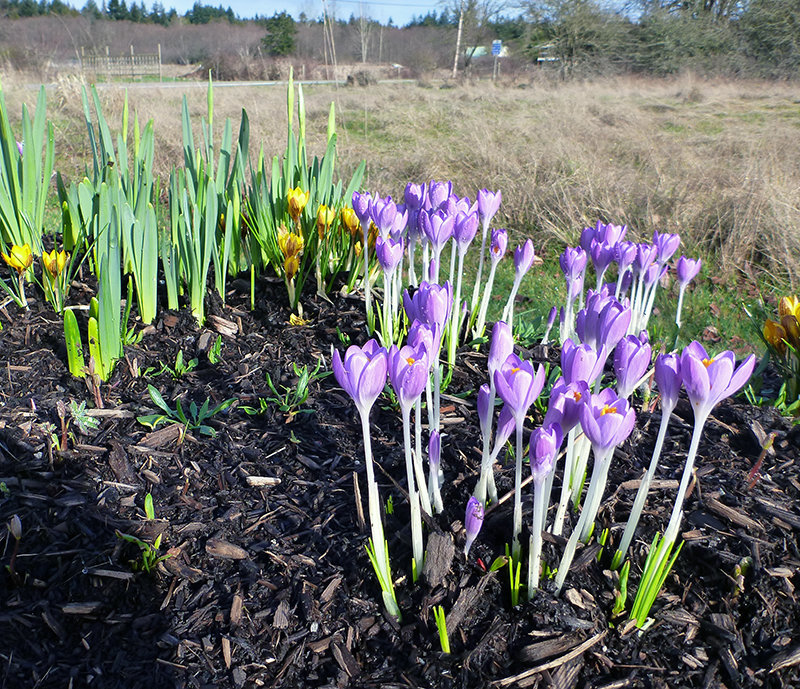 It’s not even close to spring and the crocuses are already appearing along Tyee Drive.Photo by Meg Olson
It’s not even close to spring and the crocuses are already appearing along Tyee Drive.Photo by Meg Olson
By Rhiannon Allen
Years ago, some of us discussed the use of common vs. botanical plant names in garden columns. This topic occasionally pops up in casual conversations among gardeners. Do we call it “Oregon grape” or Mahonia? Well, it’s a really good question. I grew up calling that plant Oregon grape. However, a friend staying with us a few summers ago, who happens to be both a professor of Classics and an avid gardener, wandered with us through Lily Point exclaiming about the Mahonia growing wild along trails, and regaling me with the hidden meanings of botanical names.
Common names certainly have their place in gardening parlance. We grow up either hating or sneakily admiring the cheerful yellow flowers of dandelions rather than Taraxacum. The garden of my childhood was filled with wallflowers hugging the warmth of the stone wall that surrounded our house, growing happily in ignorance of the botanical debate about whether they were Erysimum or Cheiranthus.
A few plant and seed catalogs and many retail nurseries use only the common names of plants. Throughout the world, virtually all vegetables and herbs are known and sold only by their common name. And finally, as a plug for common names, it’s hard to beat the poetry or imagery of names like bishop’s hat, bluebells, cowslip and foxglove.
But folk names have many disadvantages, the most common being their geographical variation, even within the same language. I was quite confused when I moved to Point Roberts because our landlord (from California) kept referring to the “pine” in the back yard. For the life of me, no matter how long I stared, all I saw was a Douglas fir.
Years later, I learned that many Californians use the word “pine” to refer to evergreen conifers in general, and not just members of the Pinus genus. It would have been less confusing, although perhaps absurd, if she had talked about the Pseudotsuga menziesii. To compound confusion, sometimes plants are called by different names even within the same area. Bittercress, shotweed and popweed are all the same nasty weed Cardamine hirsuta, and I have heard all three common names in use here. Fortunately, most plant and seed catalogs print both common and botanical names. For example, the Forestfarm catalog beside me lists the native species of a butterfly-sustaining plant as both Asclepias speciosa and “showy milkweed.”
So botanical names have their uses, although they often prove to be quite a mouthful. Modern botanical names were systematized by the Swedish botanist Carolus Linnaeus, partially to help cope with the large numbers of new species being discovered as a result of European exploration and increased global trade. In Linnaeus’ binomial system, each type of plant is identified by a capitalised and italicized name describing the category or genus of plant, e.g., Mahonia. This is followed by a name describing the exact species of plant, e.g., Mahonia aquifolium or its dwarf cousin Mahonia repens.
Because many New World species were novel to the Europeans doing the botanical naming, many plants are named after their European discoverer. For example, one of the shrubs planted along Tyee Drive is Escallonia, named after the Spaniard Escallon, who encountered the plant in Columbia. Mahonia honors Irish-American horticulturalist Bernard McMahon, who was the conservator of the plant collection assembled by the Lewis and Clark expedition. Other plants are named for their characteristics. The name of Rhododendrons, which originated in Asia, means rose tree. As a result of these naming traditions, one of the fun things in learning botanical nomenclature is that you learn botany and global history.
While we might think of botanical names as carved in marble once assigned, this is not strictly true. While botanical names are less mutable than common names, they do occasionally change. Such changes are usually due to the scientific recognition that a plant had been misnamed or that an entire genus of plants needed to be reorganized on the basis of new evidence. A typical muddle has been going on here for about 10 years.
Bunchberry is an attractive native groundcover member of the dogwood (Cornus) genus. For the most part, we buy bunchberry labelled as Cornus canadensis, but I have seen presumably the same plant sold as Cornus unalaschkensis. Are these the same plant or not? Well, since botanists can’t agree, gardeners probably shouldn’t worry and can skirt the debate by just calling it bunchberry.
So what is the take-home message? Call a plant whatever you need to avoid confusion. Have fun learning both the common and botanical names of plants. And in this column, please tolerate our jumble of botanical and common names.
Want to help tend the Narcissus (daffodils), or Ceonothus (California lilac) on Tyee Drive by adopting a mound? Call Scott Hackleman at 945-1552 for details.
Comments
No comments on this item Please log in to comment by clicking here